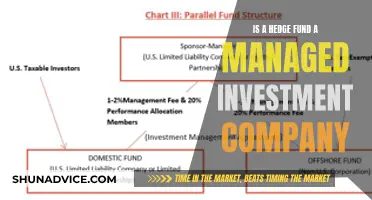
Mutual funds are a popular investment option as they offer a more diverse portfolio than straight stock purchases, thus protecting investors from catastrophic losses. While there is no legal limit to the amount of money one can invest in mutual funds, there are minimum and maximum contribution limits defined by the broker. These minimum investments, also known as a fund's minimum initial investment, ensure sufficient capitalization and help cover the fund's operating costs. For example, most retail mutual funds require a minimum initial investment of between $500 to $5,000, while institutional class funds and hedge funds require minimums of at least $100,000 or more. However, several mutual funds now offer $0 minimums, making mutual fund investing accessible to all investors.
| Characteristics | Values |
|---|---|
| Minimum investment amount | $0 to $5,000+ |
| Maximum investment amount | No limit (unless part of a tax-advantaged retirement savings plan) |
| Types | Stock, money market, bond, target-date, index, international, regional, sector, theme, socially responsible, etc. |
| Fees | Expense ratios, sales charges/loads, redemption fees, account fees |
| Investment style | Active (professionally managed) or passive |
| Risks | Market risk, interest rate risk, management risk, etc. |
| Returns | Dividends, interest income, portfolio distributions, capital gains distributions |
What You'll Learn

Minimum investment requirements
When it comes to investing in mutual funds, there is no one-size-fits-all minimum investment requirement. The minimum amount you need to invest can vary depending on several factors, including the type of fund, the fund company, and your investment goals. Here's a detailed overview of the minimum investment requirements for mutual funds:
- Mutual Fund Types: The minimum investment amount can differ between open-end and closed-end funds. Open-end funds, which don't have a set number of shares, typically require a minimum investment ranging from $1,000 to $5,000. In contrast, closed-end funds, which have a fixed number of shares, usually offer shares at a set price during their initial public offering (IPO) without a minimum investment requirement.
- Fund Companies: Different fund companies may have varying minimum investment requirements. For example, Dodge & Cox mutual funds require a minimum of $2,500, while many Vanguard mutual funds have a $3,000 minimum. Fidelity offers a range of mutual funds with $0 minimums, providing accessibility to investors with smaller budgets.
- Retail vs. Institutional Investors: The minimum investment amount can also depend on whether you are a retail or institutional investor. Retail mutual funds typically require a minimum initial investment ranging from $500 to $5,000. In contrast, institutional-class funds and hedge funds often have much higher minimums, starting at $100,000 or more.
- Account Type: The type of account you use to invest in mutual funds can impact the minimum investment requirement. For example, some companies offer lower minimums for retirement accounts like IRAs compared to non-retirement accounts. 529 college savings plans and Uniform Transfers to Minors Act (UTMA) accounts also typically have lower fund minimums.
- Investment Goals: Your investment goals and timeline can influence the minimum investment amount. If you're investing for the long term, such as for retirement or education planning, you may consider starting with a lower minimum investment and gradually increasing your contributions over time. This approach is often referred to as a systematic investment plan (SIP).
It's important to note that while some mutual funds have relatively high minimum investment requirements, there are also many funds that offer $0 or low minimums, making them accessible to a wider range of investors. Additionally, some funds may waive or reduce the minimum investment amount if you set up automatic or recurring investments.
A Guide to Investing in India's Thriving Funds Market
You may want to see also

Brokerage accounts
A brokerage account is an investment account held at a licensed brokerage firm. Brokerage accounts are generally less restrictive than retirement accounts, as there is no contribution limit and you can withdraw your money at any time for any reason. However, brokerage accounts are often not tax-advantaged, meaning you may have to pay taxes on any earnings you receive.
There are several types of brokerage accounts and brokerage firms, allowing investors to choose the model that best suits their financial needs. Here are some of the most common types:
- Full-service brokerage accounts: These accounts are offered by full-service brokerage firms that provide extensive investment advice and other wealth management services. Financial advisors are paid to help clients develop investment plans, execute trades, monitor investments, and more. Full-service brokerage accounts typically charge higher fees, including commissions on trades or advisor fees.
- Discount brokerage accounts: These accounts are offered by discount brokerage firms, which charge significantly lower fees than full-service firms but offer fewer services. Discount brokerage firms are best suited for cost-conscious investors who prefer to make their own trading and investment decisions.
- Robo-advisor accounts: Robo-advisors are digital platforms that offer financial planning, investing, and portfolio management services driven by algorithms, not humans. They are typically low-cost and have low account minimums.
- Online brokerage accounts: Online brokerages are a good choice for investors who want to select their own investments and execute trades via a website or mobile app. Many online brokerages also offer research and analysis tools to help clients make informed decisions.
When choosing a brokerage account, it's important to consider your investment goals, risk tolerance, and the level of service and support you need. Different brokers cater to different types of investors, so it's essential to find one that aligns with your needs.
To open a brokerage account, you'll need to provide some personal information, such as your address, date of birth, and Social Security number. You'll also need to fund your account before you can start investing. There is usually no fee to open a brokerage account, and many brokers allow you to open an account with no upfront deposit.
Once you have a brokerage account, you can use it to purchase various investments, including stocks, bonds, mutual funds, and exchange-traded funds (ETFs). There is no limit to how much you can invest in mutual funds through a brokerage account, but it's important to consider the fees associated with these investments, as they can impact your overall returns.
Angel Broking: Index Funds Investing Simplified
You may want to see also

Mutual fund fees
Mutual funds charge a variety of fees that can eat into your returns over time. Here is a list of the most common fees associated with mutual funds:
Expense Ratio
An expense ratio is an annual fee that covers the fund's operating expenses, including management fees, administrative costs, and marketing expenses. It is expressed as a percentage of the fund's average net assets and is deducted from the fund's returns. For example, a fund with a 1% expense ratio will cost you $10 for every $1,000 you invest.
Sales Charges or Loads
Some mutual funds charge sales fees, known as "loads", when you buy or sell shares. Front-end loads are charged when you buy shares, while back-end loads (or contingent and deferred sales charges) are assessed if you sell your shares before a certain date.
Redemption Fees
Some mutual funds charge a redemption fee when you sell your shares within a short period (usually 30 to 180 days after purchasing them. This fee is designed to discourage short-term trading in these funds for stability. The U.S. Securities and Exchange Commission (SEC) limits redemption fees to 2%.
Other Account Fees
Some funds or brokerage firms may charge extra fees for maintaining your account or transactions, especially if your balance falls below a certain minimum.
No-Load Funds
To avoid sales charges, investors can opt for no-load funds, also known as "no-transaction-fee funds". These funds charge no sales commissions when purchasing or selling shares. Most funds available to individual investors are currently no-load.
Class of Shares
The type of mutual fund shares you buy can also impact the fees you pay. Traditional A-shares come with a front-end load of up to 5% or more, plus management fees and ongoing distribution fees. To reduce fees, investors can opt for "level load" C shares, which carry a lower annual distribution fee, or Class B shares, which charge fees when investors sell their holdings.
It is important to carefully consider the fees associated with mutual funds as they can significantly impact your investment returns over time. Additionally, mutual funds may also have minimum investment requirements, ranging from $500 to $5,000, although some funds offer $0 minimums.
Mutual Funds: Safe, Diversified, and Profitable Investments
You may want to see also

Active vs passive funds
While there is no overall limit to investing in mutual funds, individual funds may impose minimum contribution requirements, which can range from $500 to $10,000 or more. Some funds, however, do not set any minimum investment amount.
Now, here is some detailed information on active vs passive funds:
When deciding whether to invest in active or passive funds, it's important to understand the differences between the two. Active funds are managed by professionals who regularly research and buy investments that are performing well or are expected to perform well. They also sell investments that are not meeting their standards. This approach requires a hands-on, active management style and aims to beat the market's average returns. Active funds tend to have higher fees due to the extensive research and analysis involved, as well as the salaries of the analyst team.
On the other hand, passive funds involve buying and holding investments over the long term, with minimal portfolio turnover. Passive investors often invest in indexed funds or mutual funds, which track a specific market index such as the S&P 500 or Dow Jones Industrial Average. Passive investing is a more hands-off approach that aims to mimic the market's performance rather than trying to beat it. This strategy often results in lower fees since there is no need to pay for active management.
Advantages and Disadvantages
Both active and passive investing have their strengths and weaknesses. Active investing offers more flexibility as managers can buy stocks that they believe will perform well, and they can use various hedging techniques to manage risk. Additionally, active management allows for tax management strategies tailored to individual investors. However, active investing is generally more expensive due to higher transaction costs and management fees. It also carries active risk, as managers may make costly investing mistakes.
Passive investing, on the other hand, offers ultra-low fees, transparency, and tax efficiency. Investors know exactly which assets are in the index fund, and the buy-and-hold strategy minimises capital gains tax. However, passive funds are limited to a specific index or set of investments, providing less flexibility. They also rarely beat the market and rely on fund managers to make investment decisions.
Performance Comparison
Despite active management's goal of outperforming the market, studies have shown that passive investing often delivers better returns over the long term. Passive investments have historically earned more money than active investments, and passive funds tend to outperform active funds consistently. This is because it is challenging for active managers to consistently pick enough winning investments to justify their high fees. However, active management may be useful for certain portions of a portfolio, such as illiquid or little-known securities.
Blending Strategies
Many investment advisors suggest blending active and passive strategies to take advantage of the strengths of both. Combining the two can help minimise the wild swings in stock prices during volatile periods and further diversify a portfolio. For example, retirees focusing on income may actively choose dividend-paying stocks while maintaining a buy-and-hold strategy. Additionally, risk-adjusted returns, which consider the level of risk taken to achieve a return, may favour active management in certain situations.
In summary, while active investing aims to beat the market through hands-on management, passive investing seeks to mimic the market's performance with a buy-and-hold strategy. Passive investing tends to offer better overall returns and lower fees, making it a popular choice for many investors. However, active investing can provide more flexibility and risk management options, making it suitable for specific situations or portions of a portfolio. Ultimately, many investors choose to blend the two strategies to maximise the benefits of both.
Axis Mutual Fund: Invest Directly with Ease
You may want to see also

Mutual fund shares
Mutual funds are an attractive option for investors as they offer the potential for higher returns than more conservative options like CDs and bonds. They also provide insulation from catastrophic losses by offering a more diverse portfolio than straight stock purchases. There is no legal limit to the amount of money that can be used to purchase mutual funds unless they are part of a tax-advantaged retirement savings plan.
Minimum Investment
Mutual funds may require a minimum contribution, which can range from $500 to $10,000, with some being higher or lower. Some funds have a $0 minimum, meaning even $5 or $10 can be enough to get started. These minimums are set by each fund to ensure they have enough assets under management (AUM) to achieve their investment goals and cover overheads.
Maximum Investment
There is no federally regulated limit to the amount of money that can be placed into a mutual fund. However, if purchasing the funds as part of a tax-advantaged retirement savings plan, there may be maximum contribution limits. For example, as of 2010, the maximum amount that could be spent on mutual funds for an Individual Retirement Account (IRA) or Roth IRA was $5,000 per year for those under 50 and $6,000 for those 50 or over.
Broker Limits
The amount of money that can be invested in a mutual fund may also be subject to minimum or maximum contribution limits defined by the broker through which the investment is made.
Value Fund Investment: Strategies for Success
You may want to see also
Frequently asked questions
There is no federally regulated limit to the amount of money you can contribute to a mutual fund, unless it is part of a tax-advantaged retirement savings plan such as a 401(k) or IRA. In that case, the maximum personal contribution depends on your age.
Mutual funds typically require a minimum contribution, often between $1,000 and $10,000. Some are higher, and some funds have a minimum of $500 to $5,000. There are also funds with a $0 minimum.
There are four main categories of mutual funds: stock, money market, bond, and target-date funds. Stock funds are further divided into funds that focus on small-, mid-, or large-cap companies, as well as funds that focus on growth, income, or value.
You can buy mutual funds directly from the company that manages the fund, from an online discount broker, or from a full-service broker. You will need a brokerage account with enough deposits to buy mutual fund shares.
Mutual funds charge annual fees, expense ratios, or commissions, which will affect your overall returns. These include expense ratios, sales charges or loads, redemption fees, and other account fees.







